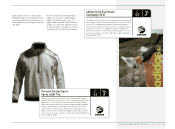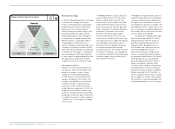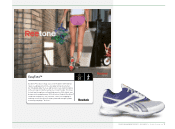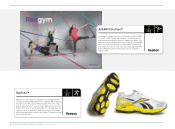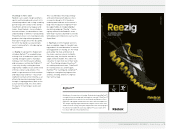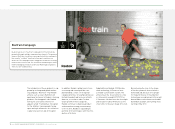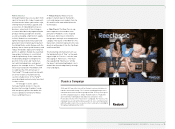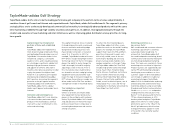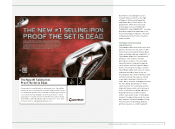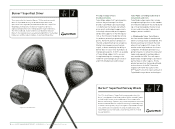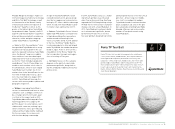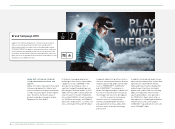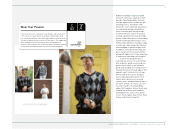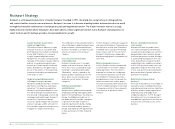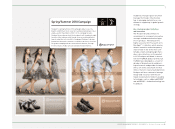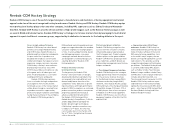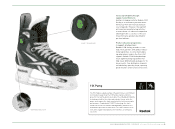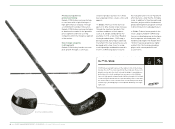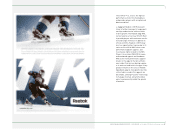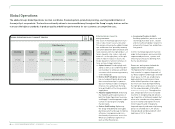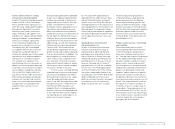Reebok 2009 Annual Report Download - page 83
Download and view the complete annual report
Please find page 83 of the 2009 Reebok annual report below. You can navigate through the pages in the report by either clicking on the pages listed below, or by using the keyword search tool below to find specific information within the annual report.
GROUP MANAGEMENT REPORT – OUR GROUP TaylorMade-adidas Golf Strategy 79
Movable Weight Technology®, Flight Con-
trol Technology, Inverted Cone Technology
and Ultra-Thin Wall Technology, as well
as the extension of the Burner® family
of metalwoods with the introduction of
the Burner® SuperFast, which, at 284
grams, is the lightest driver TaylorMade
has produced to date. Together, the R9™
SuperTri and the new Burner® SuperFast
driver will be promoted with an extensive
television, online and print campaign
called “ TaylorMade vs. TaylorMade”.
Irons: In 2009, the new Burner® irons
have provided TaylorMade with a strong
foundation for future growth in the cat-
egory. As opposed to previous TaylorMade
irons, the Burner® long-irons, middle-
irons and short-irons were developed
separately rather than in conjunction with
each other. Their immediate popularity
made Burner® the first TaylorMade iron
model to reach number one in sales in
the United States, which in turn helped
TaylorMade reach number one in iron
market share in the United States for the
first time in the brand’s history, a posi-
tion it has now held since August 2009.
In 2010, TaylorMade will leverage this
success with various product updates and
geographic expansion.
Wedges: Leveraging TaylorMade’s
success in metalwoods and irons to other
categories such as wedges continues to
be a strategic priority. Innovation again
is critical in this respect and, in 2009,
TaylorMade debuted Exchangeable Face
Technology (xFT) in the category. xFT
permits players to easily replace a worn
clubface with a new one, making it pos-
sible to maintain a fresh, spin-inducing
clubface without replacing the clubhead.
For the consumer, this is more cost-
effective than buying a new wedge.
In light of the USGA and R&A’s recent
ruling dictating that iron-groove design
must be less aggressive to promote less
backspin, xFT offers a distinct advantage
which should allow TaylorMade to grow
its market share significantly in 2010.
Putters: TaylorMade’s Rossa® Monza®
Spider high-MOI putters continued to be
in high demand by golfers everywhere,
and were used to win multiple tour
events around the world. A 2009 addition
to the line, the Monza® Spider Balero,
is extremely popular in Asia and helped
make TaylorMade the number two putter
brand in Japan. Plans in 2010 call for a
new addition to the Monza® Spider line
that incorporates the input and sugges-
tions of a variety of Tour pros.
Golf balls: Success in this category
depends on the ability to create high-
performance golf balls, bring them to
market and build credibility among Tour
professionals.
In 2009, TaylorMade’s status as a maker
of premium golf balls was enhanced
when Tour professional Yong-Eun Yang
captured the PGA Championship using a
TP Red, the first time a major champion-
ship was won with a TaylorMade ball. In
2010, TaylorMade will continue to build
on its momentum in golf balls, driven
by the Penta TP ball. This is the first
five-layer golf ball, designed to promote
optimum performance on the five critical
golf shots – driver, long-iron, middle-
iron, short-iron and partial wedges.
TaylorMade intends to enhance market-
place acceptance and sales in the golf
ball category by extending TaylorMade
branded offerings, and increasing the
number of Tour professionals using
TaylorMade balls.
Penta TP is the first tour ball to incorporate five solid layers
– cover, outer mantle, middle mantle, inner mantle and core –
each engineered to optimise performance in five key shot
categories – driver, long-irons, middle-irons, short-irons and
partial wedges. TaylorMade’s advertising calls Penta TP “the
most complete ball in golf” while telling its five-layer story. It
is well represented on the world’s tours with Sergio Garcia,
Dustin Johnson, Martin Kaymer, Retief Goosen, Justin Rose and
Jason Day all playing it.
Penta TP Tour Ball P
03


